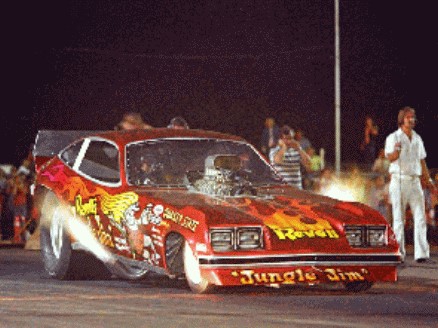



Granted modern factory electronic ignitions are good, but with M.S.D. you have the best, so get a set of big fat silicone high temperature, high voltage spark plug wires and celebrate. Well we made it from the oil pan up to the distributor so now it’s time to talk exhaust headers. You need spark plug access, solid equal length construction, rust prevention, and machine shop quality cylinder head flange flatness. They should not leak, to prevent carbon monoxide poisoning, nor should they make noise, as they should be thick enough not to burn through, because when you first fire a new engine those headers are going to glow scary bright, and if they get too light shut it down and re-fire after they cool down. Hooker headers are a good choice. They are made on Computer Numeric Control automated equipment, have machined flanges and are metallic coated for rust prevention. Smaller tube diameter is for more low engine R.P.M. power, big tube diameter are for more high R.P.M. power. Same with collector choice. This is another area where I always go bigger, because street tires don’t offer that much traction so you take away the low R.P.M. power with the big carburetor, big cam and big tube, big collector Hooker headers and put it all on top up against the rev limiter. This way you have more to look forward to as the engine starts really revving. Been to the factory, met Mr. Hooker, great stuff.
Tuning your Hot Rod:
Perfecting your combination will require experimentation, but the concepts here, you will have to understand. The engine is an air pump. The more air and fuel mixture you can move through the engine, the more horsepower you are going to make. A small engine will have to reach higher engine speed to make as much horsepower as a larger engine. Before you get ready for that high R.P.M. blast, first you will have to get your engine to idle. With a big camshaft this is difficult because the engine needs a lot of fuel and air just to idle, and typically the throttle plates will have to be opened so much, just to get the engine to run, the carburetor will no longer be on the idle mixture circuit. The carburetor will have to be disassembled and a hole drilled in each throttle plate with an idle circuit. On carburetors that have an idle circuit on all four throttle bores you must start with a smaller hole like one millimeter. Most carburetors have an idle circuit on each of the two primary throttle bores. You cannot click on undo, so here again a word to the wise, start with a small hole, like about a sixteenth of an inch or one millimeter. Then reassemble the carburetor, close the throttle plates completely, start the engine, run until it is warmed up to 180 degrees and note the idle speed. If the engine stops running when the throttle plates are closed and the engine will not idle by turning the idle speed adjustment screw a turn or so you will need to increase the size of the holes. Repeat the test. Your engine may require a single two or three millimeter hole in each primary throttle plate or about an eighth of an inch hole. The ideal situation is when the engine is idling with the primary throttle plates closed or slightly opened by the idle screw. When this is achieved the idle mixture screws will actually function again, and you can adjust the idle mixture by turning the screws until the reading on the tachometer is highest at idle. So as an example, for conversation sake, a V8 engine is idling in neutral at 900 R.P.M with an eighth inch hole in each throttle plate. With the throttle plates closed, your foot is off the throttle pedal, the throttle plates are opened only one turn of the idle speed adjustment screw. Now turn an idle mixture screw until the maximum R.P.M. is attained. Lets say you turn the idle mixture screw one way and the R.P.M. goes to 850 R.P.M., and you turn the idle mixture screw the other way and the R.P.M. goes to 950 R.P.M., leave the idle mixture screws right there at 950 R.P.M.. In an automatic transmission equipped car you put the car in first gear, with the brakes applied, and note the R.P.M.. If the engine stops running, open the throttle plates with the idle speed adjustment screw until the engine will idle without stopping. With a stock torque converter this may not be possible depending on how big the cam is. With a high stall torque converter, this is no problem. As an example a 425 horsepower 427 Chevy big block street mechanical camshaft will idle roughly with a stock torque converter, not good but you could drive it. However with the 565 horsepower L88 off road mechanical camshaft, the engine will barely run with a stock converter and is very undesirable without a high stall speed torque converter. That is why Chevrolet calls the L88 big block mechanical camshaft for off road use. The difference is dramatic. Chevrolet actually sold a few ZL1 Corvettes with automatic transmissions. The ZL1 was the all aluminum 427 equipped with the L88 camshaft. They barely idled, and barely ran. To illustrate the dramatic difference the car ran about 13.90s in the quarter mile. With a four to five thousand stall converter and a pair of slicks you could put the same vehicle in the 9.90 second club. This is dramatic. You would need low speed gears, to place the vehicle at maximum R.P.M. just beyond the finish line or as the car crosses the last speed trap light, a C454 or Holley Strip Dominator manifold, a 1050 Holley Dominator Carburetor, a set of big tube equal length headers, an M.S.D. ignition and a lightweight fiberglass cold air induction hood. I had a friend with this combination in an under 2000 pound fiberglass roadster that went 8.60 I do not recommend a 1050 or larger Holley Dominator Carburetor on the street however. This is because of excellent full throttle capabilities and not so good part throttle drivability. Oh, by the way, this combination is good for about a year of informal racing for fun.
You will need large accelerator pumps to cover the lean condition caused by opening the throttle on a large 750 – 850 cubic feet per minute airflow carburetor. All this will require is, your ability to tune the engine for the quickest throttle response. Tuning for the right fuel air mixture is a function of “reading the spark plugs” for lack of a better term. Run the engine with new spark plugs conservatively at a high enough engine speed that the engine is running on all eight cylinders (not on the carburetors idle circuit) and remove the spark plugs to observe them. If the spark plugs porcelain insulator is white or gray the fuel air mixture is too lean. This will degrade performance, burn the valves and pistons, which rely on fuel for cooling, and cause detonation. If the spark plugs porcelain insulator is black or dark brown the fuel air mixture is too rich. This will degrade performance, cover the internal parts in carbon, which will eventually cause detonation. If the spark plugs porcelain insulator is tan the fuel air mixture is just right, congratulations. For ignition timing consult the specifications for a factory high performance combination for your brand, chassis combination and remember it is better to error on the retarded side. Too much ignition advance and destructive pre ignition detonation could occur. Too retarded an ignition timing setting will result in less horsepower. If there is not much information available on the odd ball engine your Hot Rodding, from who knows where, don’t try to crank in more than 10 degrees advance before top dead center and that should get you started.
You have to get all this power to the ground somehow. While this article is primarily
about high horsepower engineering, I though I should at least point you in the right direction with regard to power transmission. Again this information is general in nature and applies to any brand, however I will use Chevrolet as an example. Presently traffic can be a nightmare and getting stuck in traffic with a manual transmission can really wear on your clutch disc and pressure plate, generally I would stay away from a diaphragm type pressure plate and use a lever type. Heat tends to destroy the diaphragm type pressure plate. The three finger Borg and Beck style are stronger, lighter and have a more switch like positive engagement. An Aluminum flywheel can also be beneficial in allowing the engine to rev quicker, however it’s use is contingent upon vehicle weight, rear end gear ratio and engine size. Consult with an expert for you brand vehicle. Generally the lighter the car, the lower the gear ratio, and the bigger the engine, the more advantageous an aluminum flywheel is. Translation: If you have a 1800 pound Street Rod with a 427 inch Big Block and 456 rear end gears, go with the aluminum flywheel.
If you have a 265 inch Small Block in a 3500 pound 55 Chevy with a 373 rear end gear you will probably need a steel flywheel. Manual verses Automatic. You would not think of race cars having automatic transmissions, however modern automatic transmissions have become formidable and a good choice for many reasons. Traffic, reliability and durability are good reasons. Traffic is an obvious reason.

